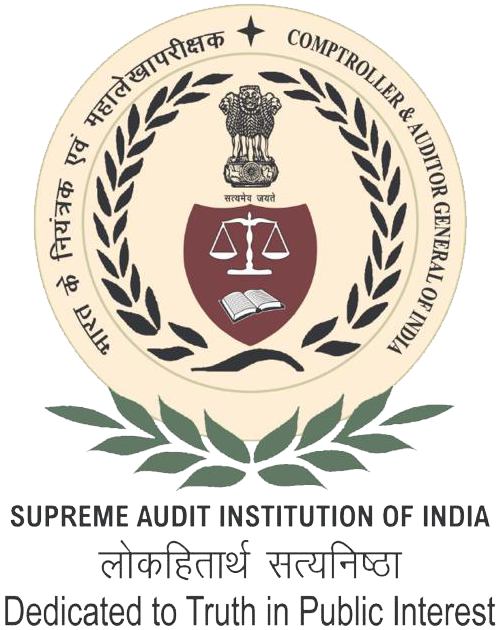- Home
- About Us
- Functions
- Resources
- Tour Programme
- Reports
- Contact Us
- Employee Corner
- NRA
- IBEMS
Audit Reports
Compliance
Performance

Meghalaya
Report No. 3 of 2020 - Revenue Sector Government of Meghalaya
Date on which Report Tabled:
Fri 19 Mar, 2021
Date of sending the report to Government:
Tue 09 Feb, 2021
Government Type:
State
Sector
Environment and Sustainable Development,Finance,Transport & Infrastructure,Taxes and Duties
Overview
The Report of the Comptroller and Auditor General of India on Revenue Sector for the year ended 31 March 2019 (Government of Meghalaya) is brought out in six chapters. The Report contains a Performance Audit on “Roll out of GST in Meghalaya” and 14 Audit Paragraphs relating to Taxation, State Excise, Transport, Forest & Environment and Stamps & Registration departments involving ₹200.35 crore. The major findings are mentioned below:
Chapter-I: General
- During the year 2018-19, the revenues raised by the State Government (₹2220.94 crore) was 22.85 per cent of the total revenue receipts (₹9718.62 crore). The balance 77.15 per cent of receipts during 2018-19 comprised of State’s share of net proceeds of divisible taxes and duties amounting to ₹4889.07 crore and grants-in-aid from Government of India amounting to ₹2608.61 crore.
(Paragraph 1.1)
- Test check of the records of taxes on sale, trade etc., state excise, motor vehicles tax, forest receipts and other non-tax receipts conducted during the year 2018-19 revealed under assessments/short/non-levy/loss of revenue amounting to ₹758.34 crore in 347 cases. During the year, the departments accepted under assessments/short/non-levy/loss of revenue of ₹213.25 crore in 133 cases pointed out in 2018-19, and recovered ₹9.65 crore.
(Paragraph 1.9)
Chapter-II: Taxation Department
Performance Audit on Roll out of Goods and Services Tax (GST) in Meghalaya
A review of the Roll out of GST in the State of Meghalaya (Model 1 State) has revealed the following deficiencies.
- The State’s Taxation Department did not make concerted efforts to create awareness of the new tax legislation amongst all-important Stakeholders such as the dealers and other Government Departments. The training imparted to its own Manpower was inadequate for them to utilise the automated system created by the NIC, to carry out their statutory responsibilities under the new tax regime.This resulted in lesser registration of dealers in comparison to the VAT regime, non-filing of returns by dealers and non-deduction of GST by DDOs mandated as per the provisions.
- The GST application system developed by NIC Meghalaya which was the backbone for successful implementation of the new law, suffered from lack of planning in the design and roll out of the back end application system. The Taxation Department did not have any formal MOU with the NIC, Meghalaya for timely completion of backend modules for the GST System. Of the 11 modules to be developed, the NIC reported partial completion of only four modules, namely, Registration, Payment, Returns and Refunds, but even in these the functionalities were incomplete.
- The GST application system was not user friendly to assist the taxation officials in ‘getting access to the tax payer’s data’ with ease for carrying out the necessary functions of issuing notices etc. The database was not being updated in real time and the time lag made it unfriendly to the dealers as well as to the Department. No MIS returns could be generated by the system to show dealers who have filed their returns and those who were defaulters.
- Dealers whose turnover had crossed the limits for availing benefits of the Composition Scheme (turnover of ₹50 lakh) were neither thrown up by the computer application system nor did the Department take any steps to deny the Scheme benefits to them.
- The Department rolled out the GST with outdated /obsolete hardware equipment and except for Shillong the internet connectivity to the tax administrators remained poor for implementing the GST, for which efficient net connectivity with modern computers/servers and other equipment is a must.
- The State had only 17692 dealers under GST as on 31 March 2019, which was only 34 per cent of the registered dealers under VAT regime migrated to GST, In absence of any exercise carried out by the Department to analyse this gap in the tax base under the MGST and its impact on the State’s revenue, we cannot give an assurance that all potential taxpayers were correctly registered under the new taxation system.
- Transitional credit claims could not be verified in absence of provisions for validation of data of TRAN1 and TRAN2, through automated verification of credit in the backend system. As a result, audit found 19 cases of irregular allowance of transitional credits of ₹72.62 lakh, which need to be rectified.
- The input tax credit claimed by dealers in their tax return (GSTR3B) did not match with the input tax credit available under GSTR 2A. The Department failed to check such excess claims of ₹113 crore of input tax credits availed by 56 dealers.
- Absence of cross checks by the taxation officials to ensure proper filing of tax returns by tax deductors at source and tax compliance by deductees/contractors provided scope to contractors to evade payment of GST by filing ‘Nil Returns’.
- In absence of effective enforcement activities in the Taxation Department and no mechanism for sharing of information across Departments, audit noticed several cases of tax evasion due to misreporting by the traders bringing goods to the State.
- In view of the deficiencies pointed out by the Audit in implementation of the GST roll out, the Government needs to increase its efforts for a comprehensive implementation plan for the GST. It also need to take remedial action on non-filing of returns by dealers under the GST and on incorrect claims/ ‘Nil’ returns filed by dealers for the period reviewed, until an efficient and user friendly computerised system is put in place.
(Paragraph 2.3)
Compliance Audit Paragraphs
- In 11 cases Audit noticed noncompliance to the provisions of the Act which resulted in non/ short realisation of VAT amounting to ₹4.90 crore
(Paragraph 2.4)
- Interest amounting to ₹1.82 crore was not levied for late payment of tax by a dealer.
(Paragraph 2.5)
- Application of incorrect rate of tax on works contract, excess claim towards labour charge and concealed turnover, by works Contractor resulted in short payment of tax of ₹2.78 crore
(Paragraph 2.6)
Chapter-III: State Excise Department
- Failure to renew licenses of 93 Indian Made Foreign Liquor (IMFL) retail, bars and canteen licensees resulted in non-recovery of ₹1.84 crore of excise revenue.
(Paragraph 3.3)
- The Commissioner of Excise (CoE) failed to realise advance licence fee of ₹2.24 crore from 38 bonded warehouses for the year 2019-20. The Department has recovered the entire amount at the instance of Audit.
(Paragraph 3.4)
- Commissioner of Excise (CoE) registered 39 brands of eight distilleries/ companies/ bonded warehouses without realising registration fee amounting to ₹19.90 lakh.
(Paragraph 3.5)
- The Department failed to obtain adequate security deposits of ₹43.10 lakh from 75 IMFL and 14 Bar licensees.
(Paragraph 3.6)
- Excise authorities failed to execute import permits resulting in non-realisation of excise duty of ₹10.56 lakh from bonded warehouses.
(Paragraph 3.7)
Chapter-IV: Transport Department
- District Transport Officers/ State Transport Authority did not realise permit fee of from 2400 commercial vehicle owners who failed to renew their lapsed permits.
(Paragraph 4.3)
- The STA neither took follow up action nor streamlined the collection system resulting in non-realisation of revenue of due to lapsed /deficient bank drafts, on countersignature of permits issued by other States.
(Paragraph 4.4)
- Despite availability of VAHAN computerised application system, the Department failed to recover road tax of ₹1.24 crore from 3437 commercial vehicles.
(Paragraph 4.5)
Chapter-V: Forest & Environment Department
- In absence of system of cross checking with custom stations, three Forest check-gates under-reported export of stone/ boulders and limestone exported to Bangladesh, resulting in non-recovery of revenue of₹1.73 crore.
(Paragraph 5.3)
- The State Forest Department failed to realise a fee of ₹11.87 crore at the check-gates while issuing transit passes to 118682 trucks, transporting limestone outside the State.
(Paragraph 5.4)
Chapter-VI: Stamps & Registration Department
- District/ Sub-Registrars incorrectly calculated stamp duty in respect of mining leases resulting in short realisation of stamp duty amounting to ₹38.87 lakh and registration fee of ₹0.29 lakh.
(Paragraph 6.3)
Download Audit Report
- Table of Content
- Preface
- Overview
- Chapter-I
- Chapter -II
- Chapter -II
- Chapter -IV
- Chapter -V
- Chapter - VI
- Appendices
- Glossary

